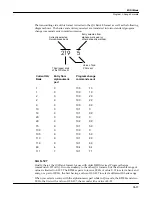
MIDI Mode
The Transmit (XMIT) Page
10-2
of your MIDI controller. If you set them to match, the remaining parameters will take effect as
well.
Control Setup
This is where you define the Control Setup, layer one of which is used by all K2500 programs.
Refer to chapters 6 and 7 of this manual for more information on the Control Setup.
Channel
This defines which MIDI channel the K2500 uses to transmit MIDI messages. The value for this
parameter matches the current MIDI channel displayed on the top line of the Program mode
page. If you change the current MIDI channel while in Program mode, the setting of this
parameter will change accordingly, and vice versa.
Transpose
This parameter affects the transposition that’s applied to the MIDI data stream. Adjusting this
parameter will transpose the K2500’s notes, as well as notes on slaves receiving from the K2500.
This transposition setting is not overridden when you use Setup mode, but is
added
to the
transposition settings for the currently selected setup.
Control
Here you determine where the K2500 sends MIDI information. A value of MIDI sends the MIDI
signal to the K2500’s MIDI Out port, but not to the K2500 itself. This is also known as Local
Control Off.
If you’re using your K2500 with a MIDI sequencer and have the K2500’s MIDI Out connected to
the sequencer’s MIDI In, and the sequencer’s MIDI Out connected to the K2500’s MIDI In a
MIDI loop, you’ll need to select a value of MIDI when your sequencer’s Patch Thru feature
(also known as Play Thru, Soft Thru, etc.) is on. This will prevent the K2500’s MIDI signal from
looping back on itself, which can cause problems. If you deactivate your sequencer’s Patch
Thru feature, set the Control parameter’s value to Both, and the K2500 will play normally. Also,
you may want to set the value of the LocalKbdCh parameter to None when you have a MIDI
loop, because you can have problems with doubled notes and MIDI overload. You won’t have
problems, however, as long as the channels transmitted by the K2500 are all different from the
incoming MIDI channel.
A value of Local disables the MIDI Out port. Use this setting when you want to play the K2500,
but not to send any MIDI information to other MIDI instruments (local control only). A value of
Both (the default) enables you to play the K2500 and send MIDI information from its MIDI Out
port.
Velocity Map—Transmit (VelocMap)
The transmit velocity map affects the way the K2500 sends velocity information to its MIDI Out
port. Different maps generate different velocity values for the same attack velocity—that is,
they apply different curves to the attack velocities the K2500 receives and remap them to new
velocities before transmitting them to the MIDI Out port.
Important: The MIDI velocity maps affect only those MIDI velocity values transmitted via the
K2500’s MIDI Out port, and are used exclusively to adjust the response of MIDI devices
connected to the Out port. If you have a DX7 connected to your K2500, for example, and the DX
is distorting, selecting a transmit Velocity Map like “Hard2” should handle the problem.
Changing the velocity map on this page will not affect the response of the K2500’s sound
engine to your MIDI controller. That’s done on the RECV page. See Chapter 17 if you’re
interested in editing velocity maps.



































